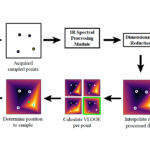
Researchers from Berkeley Lab, UC Berkeley, and Caltech devised a more efficient way to collect “high-dimensional” infrared images, where each pixel contains rich physical and chemical information. The new technique, implemented at the Advanced Light Source’s (ALS) infrared beamline 1.4, uses a grid-less, adaptive approach that autonomously increases sampling in areas displaying greater physical or chemical contrast. With the new method, scans that would’ve taken up to 10 hours to complete can now be done in under an hour.
The work was led by Molecular Biophysics and Integrated Bioimaging (MBIB) Division Senior Scientist Hoi-Ying Holman, who directs and serves as lead principal investigator for the Berkeley Synchrotron Infrared Structural Biology (BSISB) Imaging Program.
In the proof-of-concept infrared microscopy experiments, the researchers examined two samples: a two-component system composed of permanent-marker ink and high-vacuum grease; and a live, larval-stage roundworm (C. elegans). As they reported in the journal Communications Biology, in both cases, the autonomous adaptive data acquisition methods outperformed non-adaptive methods.
Read more in the ALS Science Brief.



